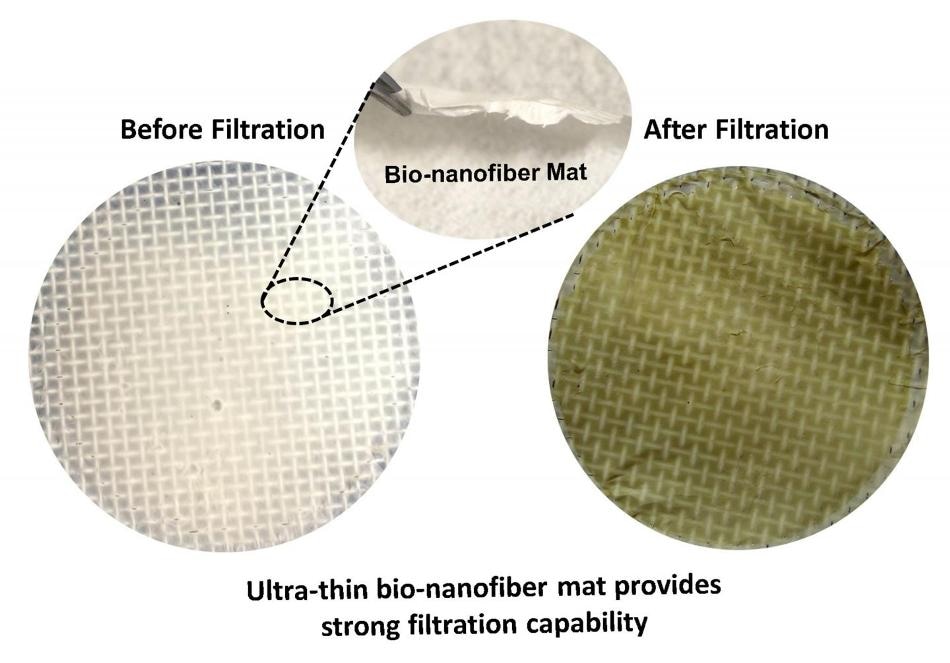Jan 16 2017
 This image shows a before and after demonstration of filter's ability. (Credit WSU)
This image shows a before and after demonstration of filter's ability. (Credit WSU)
Researchers at Washington State University have designed a soy-based air filter that is capable of capturing toxic chemicals, such as formaldehyde and carbon monoxide, which is not possible with existing air filters.
The research could result in the production of better air purifiers, especially for regions around the world that endure highly poor air quality. The team have created and tested the materials to be used for the bio-based filter. They report their findings in the Composites Science and Technology journal.
Collaborating with researchers from the University of Science and Technology Beijing, the WSU team, including Weihong (Katie) Zhong, professor in the School of Mechanical and Materials Engineering, and graduate student Hamid Souzandeh, used a pure soy protein together with bacterial cellulose for a 100% natural, biodegradable, and economical air filter.
Hazardous Gases Escape Most Filters
Poor air quality results in health problems globally and is a factor in diseases such as heart disease, asthma, and lung cancer. Commercial air purifiers focus on removing the small particles that are found in smoke, soot, or car exhaust because these damaging particles are inhaled straight into the lungs.
There are several sources of pollution in many parts of the world but air pollution alone can contain a combination of dangerous gaseous molecules, such as carbon monoxide, sulfur dioxide, formaldehyde, and other volatile organic compounds.
Most of the common air filters, which are generally manufactured using micron-sized fibers of synthetic plastics, physically filter only the small particles and are not able to chemically trap gaseous molecules. Additionally, they are most frequently made of petroleum and glass products, which results in secondary pollution, Zhong said.
Soy Captures Nearly All Pollutants
The WSU and Chinese team designed a new air filtering material made out of natural, purified soy protein and bacterial cellulose - an organic compound formed by bacteria. The cellulose and soy protein are cost effective and are already used in many applications, such as plastic products, adhesives, wound dressings, and tissue regeneration materials.
Soy has numerous functional chemical groups, which includes 18 types of amino groups. Each chemical group has the capability to capture passing pollution at the molecular level. The researchers used an acrylic acid treatment to disentangle the highly rigid soy protein, in order to expose the chemical groups to the pollutants.
The resulting filter was able to remove almost all of the small particles as well as chemical pollutants, said Zhong.
Filters are Economical, Biodegradable
Particularly in highly polluted environments, people might be inhaling an unknown combination of pollutants that could prove difficult to purify. But, with its large number of functional groups, the soy protein is capable of attracting an extensive range of polluting molecules.
We can take advantage from those chemical groups to grab the toxics in the air.
Weihong Zhong, Professor, Washington State University
Additionally, the materials are biodegradable and cost-effective. Soybeans grow abundantly in many parts of the world, she added.
Zhong visits her native China from time to time and has personally witnessed the heavy pollution in Beijing where sunny skies turn to gray smog within a few days.
Air pollution is a very serious health issue. If we can improve indoor air quality, it would help a lot of people.
Weihong Zhong, Professor, Washington State University
Patents Filed on Filters, Paper Towels
In addition to the soy-based filters, the research team has also created gelatin- and cellulose-based air filters. They are also applying the filter material on top of inexpensive and disposable paper towel to strengthen it and to enhance its performance. Patents have been filed for the technology, and commercialization opportunities are being pursued.
The research is consistent with WSU's Grand Challenges, a collection of research initiatives targeted at large societal issues. It is mainly applicable to the challenge of sustaining health and its subject of healthy communities and interventions to sustain public health.